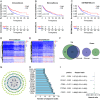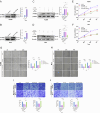Prognostic value and immune infiltration of a tumor microenvironment-related PTPN6 in metastatic melanoma
- PMID: 39732710
- PMCID: PMC11682626
- DOI: 10.1186/s12935-024-03625-6
Prognostic value and immune infiltration of a tumor microenvironment-related PTPN6 in metastatic melanoma
Abstract
Background: Cutaneous melanoma is one of the most invasive and lethal skin malignant tumors. Compared to primary melanoma, metastatic melanoma (MM) presents poorer treatment outcomes and a higher mortality rate. The tumor microenvironment (TME) plays a critical role in MM progression and immunotherapy resistance. This study focuses on the role of the TME-related gene PTPN6 in the prognosis and immunotherapy response of MM.
Methods: This study analyzed the RNA-seq and clinical data of MM patients from public databases, employing the ESTIMATE algorithm and bioinformatics tools to identify differentially expressed genes in the TME. PTPN6 was identified as a prognostic biomarker. Its expression and function were validated using in vitro and in vivo experiments. The role of PTPN6 in immune cell infiltration and its association with the JAK2-STAT3 pathway and immunotherapy response were also evaluated.
Results: PTPN6 expression was significantly lower in MM and associated with poor prognosis. In vitro, Overexpression of PTPN6 inhibited proliferation, migration, and invasion, while knockdown reversed these effects. In vivo, PTPN6 overexpression reduced tumor growth. Mechanistically, PTPN6 suppressed JAK2-STAT3 signaling pathway activation. High PTPN6 expression was positively associated with immune cell infiltration, improved immunotherapy response, and reduced PD-L1 expression.
Conclusion: The gene PTPN6, associated with the tumor microenvironment, may serve as a promising prognostic biomarker and therapeutic target for MM.
Keywords: Immunotherapy; JAK2-STAT3; Metastatic melanoma; PTPN6; Tumor microenvironment.
© 2024. The Author(s).
Conflict of interest statement
Declarations. Ethics approval and consent to participate: All animal experiments were approved by the Medical Ethics Committee of the Second Affiliated Hospital of Harbin Medical University (Ethical Review Approval Number: SYDW2024-074). Consent for publication: All authors gave their consent for publication. Competing interests: The authors declare no competing interests.
Figures








Similar articles
-
Based on scRNA-seq and bulk RNA-seq to establish tumor immune microenvironment-associated signature of skin melanoma and predict immunotherapy response.Arch Dermatol Res. 2024 May 25;316(6):262. doi: 10.1007/s00403-024-03080-3. Arch Dermatol Res. 2024. PMID: 38795156
-
Analysis on tumor immune microenvironment and construction of a prognosis model for immune-related skin cutaneous melanoma.Zhong Nan Da Xue Xue Bao Yi Xue Ban. 2023 May 28;48(5):671-681. doi: 10.11817/j.issn.1672-7347.2023.230069. Zhong Nan Da Xue Xue Bao Yi Xue Ban. 2023. PMID: 37539569 Free PMC article. Chinese, English.
-
The Analysis of PTPN6 for Bladder Cancer: An Exploratory Study Based on TCGA.Dis Markers. 2020 May 13;2020:4312629. doi: 10.1155/2020/4312629. eCollection 2020. Dis Markers. 2020. PMID: 32454905 Free PMC article.
-
The Landscape of the Tumor Microenvironment in Skin Cutaneous Melanoma Reveals a Prognostic and Immunotherapeutically Relevant Gene Signature.Front Cell Dev Biol. 2021 Oct 1;9:739594. doi: 10.3389/fcell.2021.739594. eCollection 2021. Front Cell Dev Biol. 2021. PMID: 34660598 Free PMC article.
-
Single-cell and bulk sequencing analyses reveal the immune suppressive role of PTPN6 in glioblastoma.Aging (Albany NY). 2023 Sep 21;15(18):9822-9841. doi: 10.18632/aging.205052. Epub 2023 Sep 21. Aging (Albany NY). 2023. PMID: 37737713 Free PMC article.
Cited by
-
Development and validation of an immune signature-based risk model for prognostic assessment in melanoma.Sci Rep. 2025 Mar 17;15(1):9117. doi: 10.1038/s41598-025-90917-0. Sci Rep. 2025. PMID: 40097490 Free PMC article.
-
Syndecan-4 promotes gastric cancer progression through activating TGF-β1 induced lipid reprogramming and contributes positive loop circuits.Discov Oncol. 2025 Jun 14;16(1):1104. doi: 10.1007/s12672-025-02975-5. Discov Oncol. 2025. PMID: 40516011 Free PMC article.
References
-
- Garbe C, Amaral T, Peris K, Hauschild A, Arenberger P, Basset-Seguin N, et al. European consensus-based interdisciplinary guideline for melanoma. Part 1: Diagnostics: Update 2022. Eur J Cancer. 2022;170:236–55. - PubMed
-
- Long GV, Swetter SM, Menzies AM, Gershenwald JE, Scolyer RA. Cutaneous melanoma. Lancet. 2023;402(10400):485–502. - PubMed
-
- Garbe C, Amaral T, Peris K, Hauschild A, Arenberger P, Basset-Seguin N, et al. European consensus-based interdisciplinary guideline for melanoma. Part 2: treatment - update 2022. Eur J Cancer. 2022;170:256–84. - PubMed
Grants and funding
LinkOut - more resources
Full Text Sources
Research Materials
Miscellaneous

